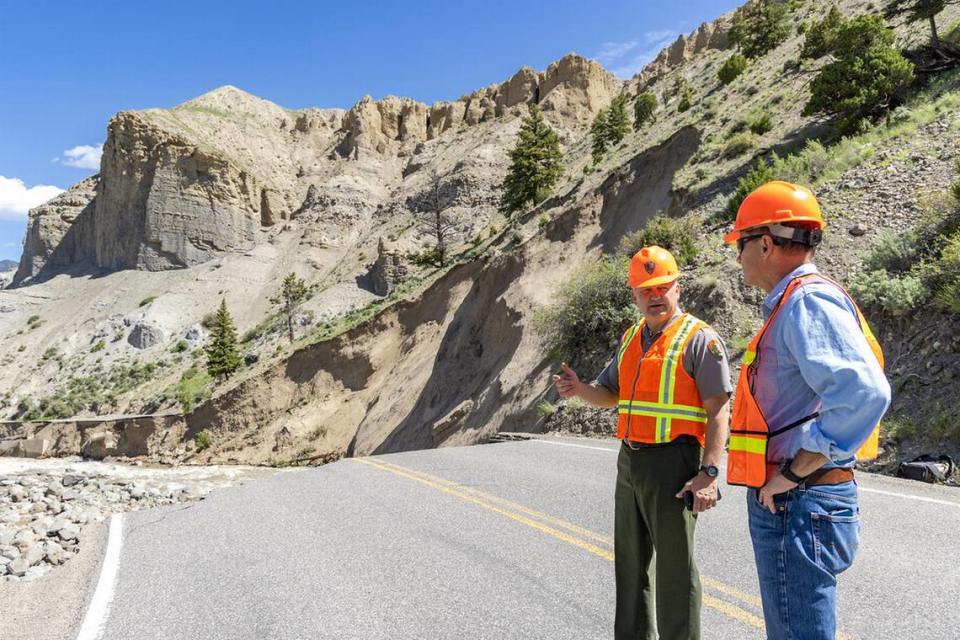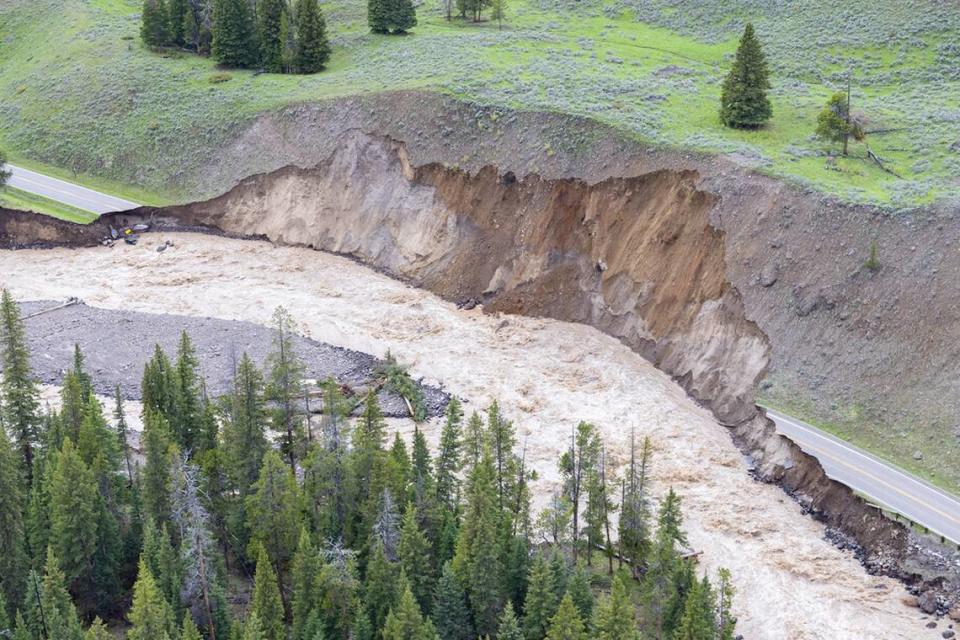Historic flooding has changed the face of Yellowstone — and could crush local businesses
A raging Gardner River gouged large chunks from the narrow two-lane road that provides tourists and workers access to Yellowstone National Park via its bustling North Entrance earlier this month, only two weeks before the summer tourism season would kick into its usual frenetic high gear.
The same day, officials closed all park entrances and hustled thousands of visitors out of Yellowstone.
Now instead of worrying about traffic jams of loaded down RVs and trailer-towing SUVs backing up through the border community of Gardiner, residents and business owners are wondering if anyone will arrive. Without access to Yellowstone, the town became a literal dead end.
“This is going to be pretty tough for Gardiner businesses to recover from,” said Bill Berg, a Park County commissioner and Gardiner resident. “Even though the park won’t open on the north end, folks in Gardiner would still like to see you come and enjoy what you can.”
Rethinking where the road goes
Park Superintendent Cam Sholly said it’s uncertain if the road will or should be rebuilt, considering it hugged the Gardner River through a narrow canyon before zigzagging uphill to Mammoth Hot Springs, Wyoming, and the park’s headquarters.
“It may not even be possible to build the road in the same alignment if you could,” Sholly said. “And I’m not sure you would want to if you could. I don’t think it’s going to be smart to invest essentially tens of millions of dollars, or however much it is, into repairing a road that may be subject to a similar flooding event in the future.”
An alternative would be to construct a new route away from the river on a new alignment to avoid future problems, he added. A dirt service road exists between Gardiner and Mammoth, but the road base is unstable.
“We are looking to make some temporary improvements to that road so that we can have some type of access between Mammoth and Gardiner,” Sholly said.

Although the route was originally considered as a way to evacuate trapped tourists and workers, Sholly said it still makes sense to keep the road open in case Highway 89, the main route north from Gardiner to Livingston, is closed again. The highway was flooded by the Yellowstone River at Yankee Jim Canyon and was temporarily opened to allow tourists to leave and delivery trucks to enter. The Montana Department of Transportation has posted the road as closed to general traffic until further notice.
Without access, Yellowstone concessionaire Xanterra Travel Collection is closing its Mammoth Hot Springs Hotel & Cabins and Roosevelt Lodge Cabins for the summer, according to Rick Hoeninghausen, marketing director. Employees at those facilities are being redeployed elsewhere in the park if they so choose.
“We’ve been quite short staffed,” he said. “So I imagine this should help us reinforce the staff elsewhere.”
The closure of the facilities saddened Hoeninghausen as bookings were strong for the summer season after two years of limited services during the pandemic.
A Yellowstone spokesperson said there is no stay-in-place order for park employees, but the agency is still working to gather information and to assess damage, which will take some time.
The plan is to reopen the “southern loop” of the park Wednesday via the entrances near the communities of Cody, Wyoming; Jackson, Wyoming; and West Yellowstone, Montana. That would allow visitors to see attractions like the Firehole River, Old Faithful, Yellowstone Lake, the Grand Canyon of the Yellowstone and Norris Geyser Basin. To reduce crowding, visitors with license plates that end with an odd number or without numbers can enter on odd days of the month; visitors with even numbers as the last digit (including zero) and motorcycle groups can enter on even days. Visitors with proof of overnight reservations in the park can enter any day, as well as commercial use operators and commercial motor coaches.
Lamar Valley critical to local communities
At the other end of the roadway that travels from Gardiner to Mammoth and onto Tower-Roosevelt, Slough Creek and the Lamar Valley are the small Montana communities of Silver Gate and Cooke City, just outside the Northeast Entrance to Yellowstone. Like Gardiner, they are now at a dead end.
“We aren’t happy they aren’t going to open our loop,” Cooke City businesswoman Suzy Hahn said.
Visitors can still access the communities via the Chief Joseph Scenic Byway from Wyoming (Highway 296), but not by the Beartooth Scenic Byway from Red Lodge, which remains closed following the flooding and will need extensive reconstruction to reopen.
The Beartooth Highway was closed in 2005 on the Montana side (the Wyoming border cuts through the road) following damage caused by a similar rain-on-snow storm that sent water gushing down the steep mountains, washing out several sections of road. It cost more than $13.55 million to rebuild the roadway in a hurry-up effort over the course of four months. Those repairs appear to have weathered the storm.
Even with that main artery cut in 2005, Cooke City visitors still had access to Yellowstone National Park. But last week, Sholly said the northern portion of the park will remain closed through the summer due to damage to the road through the Lamar Valley. Aerial footage showed two large washouts of the road caused by Soda Butte Creek and the Lamar River.

“The road from Lamar Valley to Cooke City is an area that has been substantially impacted,” Sholly said, noting that the Lamar River had changed course, “perhaps permanently.”
“If they could patch those two areas we would have access to the Lamar Valley, which is our bread and butter,” Hahn said. “We have to save our summer. Our season just started this week. You can’t cut us off.”
Kara Schlabach, who co-owns a coffee shop in Cooke City, said she’s already had to lay off an employee because of the projected drop in business.
“This is absolutely crippling for our small communities that rely on so much of the park, not just for our summer revenue, but that money we make in the summer time carries us through the extremely quiet shoulder seasons and mediocre winter,” she wrote in an email. “For restaurants like the Beartooth Cafe and the Log Cabin Cafe, who are only open in the summer time, it’s almost unimaginable.”
What this will mean for winter access to the two communities is also uncertain. The road from Cooke City through Silver Gate and onto Gardiner is the only route in Yellowstone that’s plowed all winter. It’s a popular route for park wolf watchers, as well as skiers, snowmobilers and ice climbers venturing into the region’s mountain playgrounds. Over the years, Cooke City residents have been divided over plowing the highway from Cooke City to the Chief Joseph Scenic Byway. This winter that may be the only way to access town, although some snowmobilers leave a car at the parking area and ride into Cooke City.
A portion of the road between Cooke City and Silver Gate was washed out at Sheep Creek, according to residents, but has been repaired enough to allow traffic.
Both towns are in Park County. Without road access through Yellowstone, the drive to the county seat in Livingston will take four hours instead of two-and-a-half. County Commissioner Berg noted without the more direct route, it will complicate everything from garbage service to law enforcement response times, along with necessities like mail service and food deliveries to restaurants. There are also three county bridges near Cooke City that washed out and need to be repaired.
“So the landscape, literally and figuratively, has changed dramatically in the last 36 hours,” he said on Tuesday.
The worst flood since?
Some people have referred to the flooding as a 100-year, 500-year and even a 1,000-year event because of how high the water flowed and the damage caused. Certainly river flows topped any previous record from data collected in the past 100 years, but farther back than that is unknown.
“The stream channels are shaped by large floods,” said Cathy Whitlock, a regents professor in paleoecology at Montana State University. “So it’s not unheard of to see these large floods.”
Research has shown torrential floods about 12,000 years ago caused by a rockslide at Yankee Jim Canyon that blocked off the Yellowstone River and created a large lake all the way back to Gardiner. Eventually, the dam burst, sending rock, debris and water gushing downstream.
Before that, at the end of the last Ice Age, glacial dams at Slough Creek turned the Lamar Valley into a lake. After melt water rose enough to float the glacier, a torrent would rush out underneath and downstream, helping to carve existing features like the rugged Black Canyon of the Yellowstone. Bozeman scientist Ken Pierce calculated the largest flood had a depth of 60 meters.
“So flooding isn’t anything new, it’s just we haven’t seen this magnitude of flooding,” Whitlock said.
Whitlock is one of several scientists who have studied the history of climate change in Yellowstone National Park, helping to write an assessment released last year. She called that document timely because “extreme climate events are really well predicted in climate models.” That includes more moisture in the spring, so more likelihood of rain-on-snow events like the one that caused this month’s flooding.
“I feel like this is completely consistent with what we’ll see in the future,” she said.
What’s more, she said the flooding revealed that much of the current infrastructure — from houses to roads, bridges and water treatment and sewer plants — is in the wrong place, namely next to rivers.
Unfortunately, the runoff — although record-setting — will do nothing to help ease the drought that covers much of Montana.
“The weather can flip really fast,” she said. “Superimposed are these extreme climate events.”

 Yahoo Sports
Yahoo Sports 